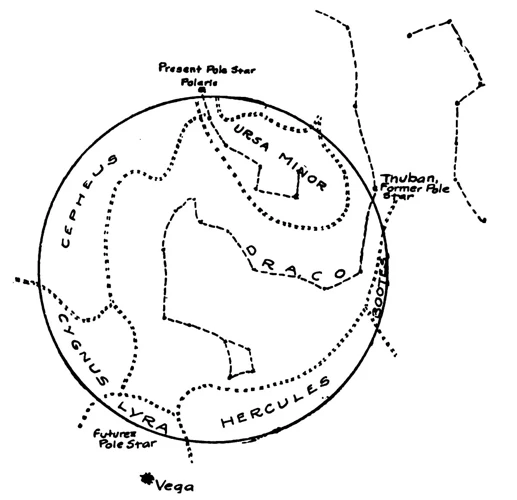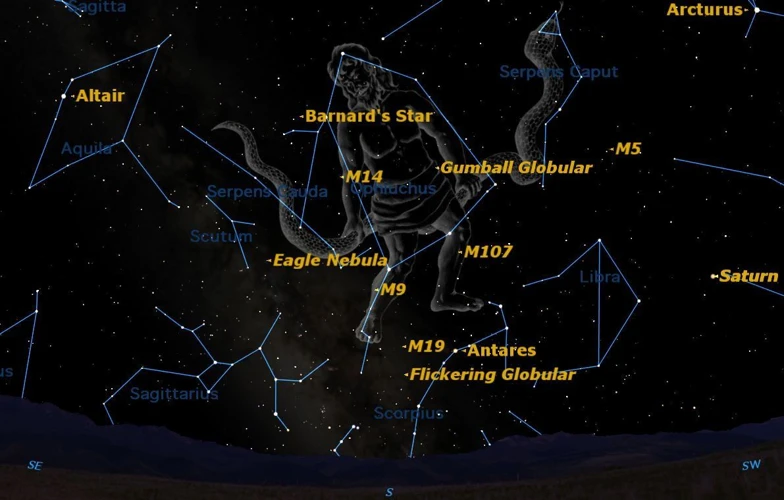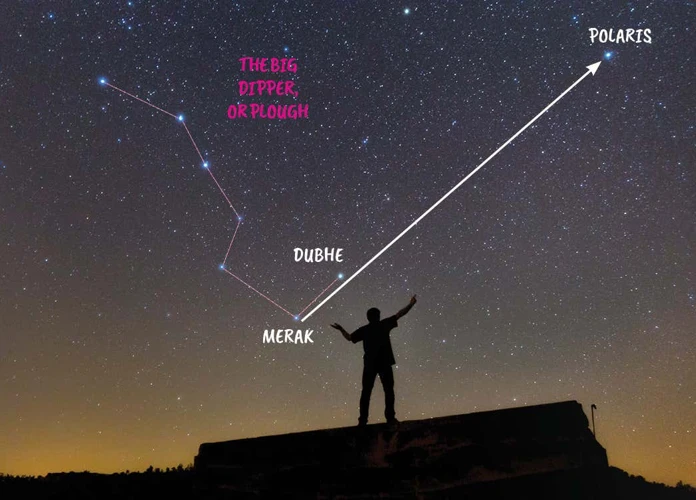Unraveling the Mysteries of Polaris: The North Star in the Northern Constellations
Have you ever gazed up at the night sky and wondered about the twinkling stars? Among them, one star stands out – Polaris, also known as the North Star. This captivating celestial object has captured the imagination of humans for centuries, serving as a constant reference point in the vastness of the night sky. In this article, we will delve into the secrets of Polaris, exploring its historical significance, its position in the sky, and its role in celestial navigation. We will also unravel the mystical and symbolic interpretations surrounding this enigmatic star. So, join us on this cosmic journey as we uncover the wonders hidden within the Northern constellations and decipher the celestial secrets of Polaris.
Polaris: The North Star

At the center of the Northern constellations, we find Polaris, the North Star. This stellar marvel has long been regarded as a guiding light in the night sky, with its unwavering position marking the direction of true north. The importance of Polaris cannot be overstated, as it has aided mariners and explorers in finding their way for centuries. Not only does Polaris serve as a reliable landmark for celestial navigation, but it also holds significant historical and cultural significance. Its steady position as the brightest star in the Ursa Minor constellation has allowed it to captivate the minds of astronomers and stargazers alike. To fully appreciate the wonders of Polaris, we must understand its historical significance, its position in the sky, and its role in our celestial navigation. So let us embark on this celestial journey and unravel the mysteries hidden within the cosmic tapestry of Polaris.
1.1 The Importance of Polaris
The importance of Polaris, the North Star, cannot be overstated in the realm of celestial navigation. For centuries, sailors and explorers have relied on the steady presence of Polaris to determine their bearing and find their way in the vast expanses of the Earth’s oceans. Unlike other stars, Polaris appears relatively fixed in the night sky, aligned closely with the Earth’s axis of rotation. This unique characteristic allows Polaris to serve as a reliable reference point, guiding navigators towards the North Pole or True North. The ability to consistently locate Polaris has been instrumental in facilitating long-distance voyages and circumnavigation of the globe. But the significance of Polaris extends beyond maritime exploration. Its position at the end of the handle of the Little Dipper, which is part of the Ursa Minor constellation, also makes it a helpful marker for locating other prominent stars and constellations in the northern sky. By aligning with Polaris, observers can easily identify the Little Dipper and Cadence Constellations. This makes Polaris not only a practical tool for navigation but also a celestial landmark that connects us to the wonders of the cosmos. To fully appreciate the importance of Polaris, it is essential to explore its historical significance, its position in the sky, and its influence on celestial navigation. So, let us continue our celestial journey and unravel the mysteries of this brilliant guiding star.
1.2 Historical Significance
Historically, Polaris has held significant importance across various cultures and civilizations. Ancient Greek and Egyptian astronomers recognized the unique position of Polaris as a fixed point in the sky, remaining relatively still while the other stars appeared to rotate around it. This stability made it an invaluable tool for navigation, especially for maritime exploration. The Phoenicians, renowned seafarers of the ancient world, used Polaris as a guide to navigate the Mediterranean Sea. Similarly, Viking sailors relied on Polaris during their legendary voyages across the Atlantic. The historical significance of Polaris extends beyond navigation. In ancient mythology, Polaris was often associated with heavenly gods and goddesses, serving as a point of reference in celestial stories. For example, in Greek mythology, the constellation Ursa Major, which contains Polaris, was believed to represent the nymph Callisto who was transformed into a bear by the goddess Hera. Polaris has been linked to various cultural practices and rituals. From ancient traditions to modern customs, the historical significance of Polaris continues to be celebrated and explored. To fully grasp the cultural and historical importance of Polaris, it is essential to delve into the mythology and folklore associated with its constellation, Ursa Major. By understanding the stories intertwined with this constellation, we can appreciate the deep-rooted connection between humans and the stars above. For more insight into Ursa Major and its fascinating tales, consider exploring the captivating wonders of “The Marvels of Bootes: Unveiling the Herdsman”.
1.3 Position in the Sky
Polaris, also known as the North Star, holds a significant position in the night sky. Located in the constellation Ursa Minor, it shines brilliantly as one of the most prominent stars in the Northern Hemisphere. The unique attribute of Polaris lies in its proximity to the celestial north pole, making it a reliable indicator of true north. Due to the Earth’s axial tilt, the North Star appears to remain almost stationary throughout the night and the year, while other stars appear to revolve around it in a circular pattern. Its position above the Earth’s North Pole grants it an elevation angle equal to the latitude of the observer. For example, someone located at a latitude of 40 degrees North would find Polaris positioned 40 degrees above the northern horizon. This makes Polaris an invaluable navigational tool, allowing sailors, hikers, and astronomers to determine their latitude by simply measuring the angle between the North Star and the horizon. To further understand Polaris’s significance, it’s worth exploring the neighboring constellations such as Ursa Minor, also known as the Little Bear, and learning about the myths and wonders that surround this constellation’s appearance in the night sky.
Constellations of the Northern Sky

Beyond the majestic presence of Polaris, the Northern sky is adorned with a collection of captivating constellations that have intrigued astronomers and storytellers throughout history. One of the most recognizable is Ursa Major, also known as the Great Bear, with its iconic Big Dipper asterism. This constellation has been a reliable guide for navigators and explorers, leading them on their journeys across land and sea. Not far from Ursa Major, we find its smaller counterpart, Ursa Minor, housing the famous Little Dipper and, of course, the North Star itself. Cassiopeia, another enchanting constellation, graces the night sky with its distinctive shape resembling a “W” or a “M,” depending on its orientation. And let us not forget about Cepheus, the King, an often overlooked but fascinating constellation that holds its own tales and mysteries. As we embark on our exploration of the Northern constellations, these celestial wonders will guide us through the ever-expanding cosmos, each with its own stories and cosmic wonders to behold.
2.1 The Great Bear (Ursa Major)
The Great Bear, also known as Ursa Major, is one of the most prominent and recognizable constellations in the northern sky. Its distinctive shape resembles a large saucepan or a plough, earning it the nickname “The Plough” in some regions. This constellation is composed of seven bright stars that form the outline of a bear. The star formation within Ursa Major includes some well-known stars, such as Alkaid, Mizar, and Dubhe. Alkaid is located at the tip of the bear’s ‘tail’, while Mizar and Alcor form a famous double star system. Dubhe and Merak, the two stars at the front of the pan or plough, are often referred to as the “pointer stars” because they guide observers towards Polaris, the North Star. Ursa Major is also home to the captivating asterism known as the Big Dipper. This formation consists of the seven main stars of the Great Bear that create a distinctive ‘bowl’ and ‘handle’ shape. The Big Dipper is a popular navigational tool and is widely recognized in various cultures around the world. Its position in the sky and its prominence in mythology make Ursa Major a celestial wonder that continues to captivate astronomers and stargazers alike. To learn about another fascinating constellation, check out our guide to Auriga, the Northern Charioteer.
2.2 The Little Dipper (Ursa Minor)
The Little Dipper, also known as Ursa Minor, is a prominent constellation in the northern sky. Its distinctive shape resembles a small ladle or dipper, hence the name. The seven main stars that form this constellation are less bright and visible compared to its counterpart, the Great Bear (Ursa Major). However, one of these stars holds immense importance – Polaris, the North Star. Located at the end of the handle of the Little Dipper, Polaris has served as a steadfast guide for navigators throughout history. It is often used in conjunction with the Big Dipper (part of Ursa Major) as a means of locating the North Star. The constellation of Ursa Minor itself has a rich mythological history. According to Greek mythology, it represents Callisto, a nymph who was transformed into a bear and later immortalized in the sky. The Little Dipper is also closely linked to the constellation of Bootes, the Herdsman, with the two constellations appearing to interact. By tracing the stars of the Little Dipper and exploring their celestial connections, we can gain a deeper appreciation for the wonders of the night sky. For further exploration of the constellations and their fascinating stories, be sure to check out our article on the marvels of Bootes, unveiling the Herdsman here.
2.3 Cassiopeia
Cassiopeia
Cassiopeia is a captivating constellation in the Northern sky that is easily recognizable for its distinctive “W” shape. Located near Polaris, it is visible year-round in the northern hemisphere. According to Greek mythology, Cassiopeia was an Ethiopian queen known for her beauty and vanity. The constellation represents her seated figure in a chair, appearing as though she is looking down on the cosmos. Cassiopeia is also home to several fascinating celestial objects, including the famous “Eta Cassiopeiae” star system, which consists of multiple stars orbiting each other. This system dazzles astronomers with its intricate dance of stellar companionship. Another noteworthy feature of Cassiopeia is the “Heart and Soul” Nebulae, two adjacent regions of glowing gas and dust that give birth to new stars. These nebulae are a sight to behold, with their vibrant colors and ethereal beauty. Cassiopeia has long captured the imagination of astronomers and stargazers alike, offering a celestial canvas of wonders to explore. So, next time you gaze upon the night sky, take a moment to admire the enchanting splendor of Cassiopeia and the mysteries it holds within its star-studded embrace.
2.4 Cepheus
Cepheus is a constellation that holds a place of prominence in the northern sky. Named after the mythical king of Aethiopia in Greek mythology, Cepheus is often depicted as a regal figure donning a crown. This celestial monarch can be found neighboring the constellation Cassiopeia and is easily recognizable due to its distinctive shape. Cepheus is composed of several stars, with the brightest among them forming a pattern that resembles a pentagon. One of the notable stars within Cepheus is Delta Cephei, which is famous for its variability. This star undergoes periodic changes in brightness, making it an essential tool for measuring cosmic distances. The constellation Cepheus holds intriguing cosmic treasures beyond its distinctive shape; it is home to various deep-sky objects such as the Wizard Nebula and the cave nebula. These stunning astronomical objects are a captivating sight for amateur and professional astronomers alike. So if you ever find yourself stargazing on a clear night, don’t forget to look up and appreciate the wonder and beauty of Cepheus.
Polaris and Celestial Navigation

In the realm of celestial navigation, Polaris shines as an indispensable guide. Its unique position in the sky, directly above the Earth’s North Pole, makes it an ideal point of reference for determining direction and finding true north. For centuries, travelers, sailors, and explorers have relied upon the unwavering presence of Polaris to orient themselves. By observing the angle of Polaris above the horizon using specialized tools like sextants and astrolabes, navigators can calculate their latitude with remarkable accuracy. As the Earth rotates on its axis, all other stars in the sky appear to move except for Polaris, which remains stationary. This steadfastness allows sailors and adventurers to chart their course and maintain a constant heading. The symbolic significance of Polaris as a guiding light in the vastness of the night sky cannot be underestimated, as it represents hope, direction, and steady navigation in a world filled with uncertainties. So, whether you are navigating the open seas or exploring the wonders of the universe, let Polaris be your guiding star.
3.1 Polaris as a Navigator’s Guide
As a navigator’s guide, Polaris holds immense significance due to its consistent position in the night sky. Because it aligns closely with the Earth’s axis of rotation, Polaris appears to remain fixed while other stars and constellations appear to move throughout the night. This steadfastness makes Polaris a reliable reference point for sailors, explorers, and even aviators, who can determine their direction based on the star’s location.
Navigators rely on Polaris to determine their latitude. By observing the angle between the horizon and Polaris, known as the star’s altitude, mariners can gauge their own position relative to the Earth’s equator. The higher Polaris appears in the sky, the closer the navigator is to the North Pole. Alternatively, when Polaris is low on the horizon, it indicates a closer proximity to the equator.
To make precise measurements, navigators often use instruments like astrolabes or sextants. These tools enable them to measure the angle between Polaris and the horizon accurately. By comparing this angle with reference charts, sailors can calculate their latitude and adjust their course accordingly.
By using Polaris as their navigational guide, sailors and explorers have been able to venture into uncharted territories, undertaking daring voyages of discovery throughout history. Polaris has truly been a guiding light in the immense darkness of the open sea, enabling adventurers to navigate safely and accurately across vast distances.
Polaris serves as a vital tool for navigators, providing them with a constant reference point and guiding them on their journeys through the unknown. Its unwavering position and dependable presence have made it an essential companion for those who brave the seas and conquer new horizons.
3.2 Using Polaris to Find True North
Using Polaris as a navigational tool to find true north has been a reliable method for centuries. To utilize Polaris for this purpose, one must first locate the North Star in the night sky. Fortunately, Polaris is relatively easy to find, as it sits at the end of the handle of the Little Dipper, also known as Ursa Minor. [Link to Exploring Ursa Minor: The Little Bear] Once Polaris is identified, it can guide travelers in determining their direction.
To find true north using Polaris, one can follow a few simple steps. First, locate Polaris and stand facing it. Keep in mind that Polaris will always be at the same position in the sky, regardless of your location. Next, extend your left arm out to the side and point it straight towards Polaris. Your outstretched left arm now points to the general direction of true north.
To refine your navigation even further, you can use your left hand to form the shape of the letter ‘L’ with your thumb and forefinger. Align your thumb with Polaris and extend your index finger perpendicular to your thumb. The point where your index finger intersects the horizon is an approximate location of true north.
It is important to note that using Polaris alone may not provide pinpoint accuracy, especially in areas close to the equator or in regions far from the Northern Hemisphere. Additionally, factors such as atmospheric conditions and obstacles on the ground can affect the accuracy of this method. It is always advisable to use Polaris in conjunction with other navigational tools for a more precise determination of true north. By understanding the position and significance of Polaris, we can unlock the secrets of celestial navigation and confidently navigate the vastness of the Earth.
Mystical and Symbolic Interpretations
Throughout history, Polaris has held mystical and symbolic interpretations that have fascinated cultures across the globe. In mythology, Polaris has often been associated with concepts of guidance and stability. For instance, in Greek mythology, it is believed to represent the celestial axis around which the heavens revolve. In astrology, Polaris is seen as a symbol of unshakable guidance and a steadfast presence in one’s life. Its position as the North Star aligns with ideas of finding one’s true path and navigating through life’s challenges. Additionally, Polaris is sometimes associated with spiritual enlightenment and inner wisdom. The symbolism surrounding Polaris extends beyond individual beliefs, with its representation in constellations and ancient astronomical maps serving as a testament to its enduring significance throughout human history. Whether through myth or astrology, Polaris continues to captivate our imaginations and inspire our sense of wonder and exploration in the vast cosmos.
4.1 Polaris in Mythology
In various mythologies around the world, Polaris holds a prominent place as a guiding star and a celestial figure of great significance. One of the most notable mythological associations with Polaris is found in Greek mythology. The ancient Greeks believed that the star represented the goddess Callisto, who was transformed into a bear by the jealous goddess Hera. Callisto, in her bear form, was then placed in the sky as the constellation Ursa Major, with Polaris serving as her guiding light. This mythological tale explains the close relationship between Polaris and the Great Bear constellation. The star’s constant position in the sky symbolizes constancy and guidance, reminding us of the deep connection between mythology and the celestial wonders above.
In Native American mythology, Polaris is also known by various names, including the “Star That Never Moves” or the “Nail-Star.” In many tribes, it is believed to be the pivot point around which the entire sky rotates. Native American cultures often associate Polaris with the concept of stability and steadfastness. It is considered a guardian and a provider of direction, offering guidance to those who traverse the Earth. The symbolic significance of Polaris in Native American mythology reflects the practical importance of the star in guiding travelers and explorers during their journeys.
The significance of Polaris in mythology extends beyond these examples. In Chinese mythology, it is associated with the Celestial Palace and considered a guiding star for immortals. In Hindu mythology, Polaris is linked to the god Dhruva, who was transformed into the Pole Star as a reward for his devotion. These diverse mythological tales showcase the universal appeal of Polaris and its role as a symbol of direction, guidance, and celestial importance in different cultures across the globe. Its enduring presence in mythology is a testament to the human fascination with the mysteries of the night sky and the stories we create to make sense of the celestial wonders above us.
4.2 Polaris in Astrology
Astrology, the ancient and mystical art of interpreting celestial bodies’ influence on human affairs, has also found connections to Polaris, the North Star. In astrology, Polaris symbolizes guidance, stability, and direction in one’s life. It is believed to have a significant impact on a person’s destiny and spiritual journey. Polaris is often associated with the concept of the “North Node” in astrology, which represents the path of growth and development that an individual should follow in their lifetime. People born under the influence of Polaris are said to possess leadership qualities, a strong sense of purpose, and the ability to navigate through life’s challenges with unwavering determination. They are believed to be natural guides and beacons of light for those around them. In astrological interpretations, Polaris is regarded as a powerful and auspicious star, bestowing its celestial energy on those in its astrological vicinity. Its luminosity is thought to illuminate the way, bringing clarity, inspiration, and enlightenment to those who seek its guidance. It is important to note that while Polaris holds importance in astrology, its role may vary depending on the specific belief systems and astrological traditions. Nonetheless, the association between Polaris and astrology adds another layer of mystery and intrigue to this captivating star.
Conclusion
The mysteries of Polaris, the North Star in the Northern constellations, have been unraveled, revealing a wealth of knowledge and wonder. From its historical significance to its position in the sky, Polaris has captivated generations with its unwavering presence. Celestial navigation has relied upon the steadfast guidance of Polaris, serving as a reliable guide for mariners and explorers. Furthermore, the symbolic and mystical interpretations of Polaris have enriched our understanding of this celestial marvel. From mythology to astrology, Polaris has held a significant place in human culture and imagination. As we conclude our exploration of Polaris, we can appreciate the profound role it plays in connecting us with the vast universe. So, the next time you gaze up at the night sky and spot Polaris shining brightly, take a moment to reflect on the mysteries it holds and the wonders that lie beyond our reach.
Frequently Asked Questions
1. How did Polaris become known as the North Star?
Polaris earned its title as the North Star due to its unique position in the sky. Its position aligns closely with the Earth’s axis of rotation, causing it to remain almost motionless while other stars appear to rotate around it.
2. Why is Polaris important for celestial navigation?
Polaris serves as a valuable navigational tool because its position in the sky is directly above the North Pole. Navigators can determine their latitude by measuring the angle between the horizon and Polaris, helping them find their way in the vast ocean or uncharted terrains.
3. How far away is Polaris?
Polaris is roughly 434 light-years away from our solar system. It may seem far, but in astronomical terms, it is considered relatively close by.
4. Can Polaris be seen from the Southern Hemisphere?
No, Polaris cannot be seen from the Southern Hemisphere. Its location near the North Pole makes it visible only from the Northern Hemisphere.
5. Is Polaris the brightest star in the night sky?
No, Polaris is not the brightest star in the night sky. It is, however, the brightest star in the Ursa Minor constellation and holds significant navigational importance, despite its moderate brightness.
6. Are there any other stars that can help in navigating the night sky?
Apart from Polaris, several other stars serve as navigational aids. The constellations Ursa Major, Cassiopeia, and the constellation Orion’s belt offer valuable reference points for finding your way in the night sky.
7. How does the position of Polaris change over time?
The position of Polaris is not fixed. Due to a phenomenon called precession, Earth’s axis slowly shifts over time, causing the apparent position of Polaris in the sky to change. In about 12,000 years, a different star will take over as the North Star.
8. Can Polaris be used for timekeeping?
Polaris is not commonly used for timekeeping. However, its position in the sky can help determine the time of night or day based on its alignment with other stars and the horizon.
9. What is the mythological significance of Polaris?
In Greek mythology, the constellation Ursa Minor and its prominent star, Polaris, were associated with the story of Callisto, who was turned into a bear and placed in the sky by Zeus.
10. Is Polaris visible year-round?
Yes, Polaris is visible year-round in the Northern Hemisphere. However, its position in the sky may vary slightly depending on the season and the time of night.








